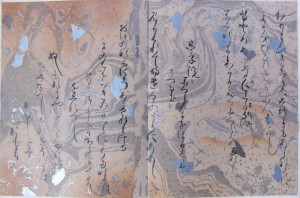Membership

First Hypatia poetry broadside takes shape!
Pat’s post about Hypatia’s 2nd broadside reminded me that I’d written about the first back in March, back before the new web was live. This is old news by now — we’ve sent out many of the first printing as membership premiums and, as Pat wrote, are well started on the second, but the beginning, the first turn of the press, was so much fun, I just have to share this.
March 11, 2012: The press clacked and sighed as Pat turned the handle, then was quiet while I picked each newly printed broadside from the cylinder. Crisp letters on fine, muted papers. Four of us were printing broadsides, the poem “Swallowing the World” by local poet Don Freas. Probably a hundred repetitions for the seventy-four good copies printed. The others were proofs: determining placement on the page, realigning the plate after we cleaned the bed, checking the inking.
(more…)

The Next Poetry Broadside is Underway

Two pages of waka poems by Ōshikōchi Mitsune (859?-925?). 20cm height, 32cm wide. Silver, Gold, Color, and ink on suminagashi paper. From a copy of the Sanjurokunin Kashu or “Thirty-Six Immortal Poets” kept in the Hongan-ji Temple, Kyoto. This multi-volume manuscript, which contains the oldest examples of marbled paper known today, was presented to the Emperor Shirakawa on his sixtieth birthday in 1118 C.E.
“墨流し suminagashi, which means ‘floating ink’ in Japanese is the oldest method of decorative paper made with floating colors that is known today. Author Einen Miura states that the oldest reference to suminagashi papers are in the waka poems of Shigeharu, (825-880 CE), a son of the famed Heian era poet Narihira. Various claims have been made regarding the origins of suminagashi. Some think that it may have originally come from China. Others have proposed that it may have derived from an early form of ink divination. Another theory is that the process may have derived from a form of popular entertainment at the time, in which a freshly painted sumi painting was immersed into water, and the ink slowly dispersed from the paper and rose to the surface, forming curious designs. (more…)